Review: Drone dogfight — Parrot Bebop vs DJI Phantom
Fancy a drone you can program to fly from A to B? Or one that follows you?
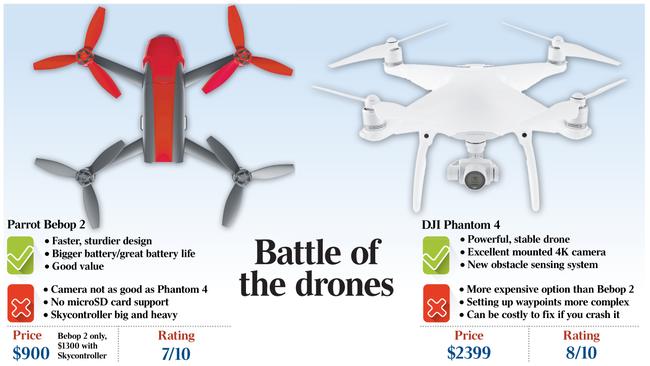
Fancy a drone you can program to fly from A to B? Or one that follows you?
Today’s consumer drones offer more capabilities than ever. Multiplayer gaming, voice control, autonomous and formation flying are all features available for enthusiasts.
As regulators scramble to work out the laws around the use of drones, the devices themselves are getting better and smarter. I’ve been trialling the more advanced features of the latest Parrot and DJI models, Parrot Bebop 2 and the DJI Phantom 4, and there are some hits but also misses.
Parrot Bebop 2
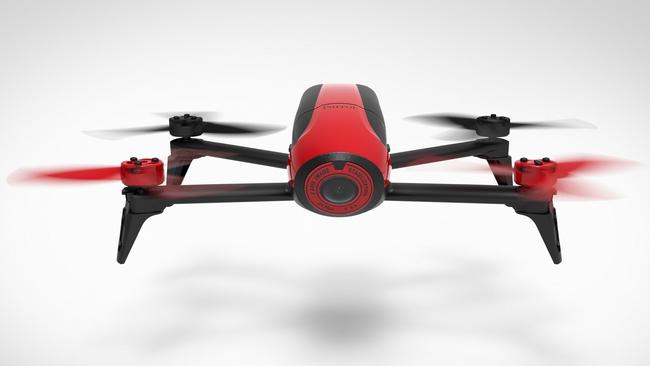
One advanced feature widely available to the general public is pre-programmed flight navigation. In advance of your flight you organise where a drone flies by tapping on a map at “waypoints” — points on the route.
To use extended navigation you buy and download the Parrot Flight Plan app for iOS and Android. It costs $30.99 but it extends the capabilities of the Parrot FreeFlight 3 app used by Bebop 2.
The app lets you set up a flight plan even before you travel to where you’ll fly the drone. If you use a device without a SIM card or are flying in an area without internet, you’ll need to download the map beforehand.
Creating waypoints is easy. I tapped on the map where I wanted the Bebop to travel to and at each waypoint I used a slider to select the speed, altitude and camera direction.
I could also choose points of interest on the map, and define where the drone camera would face that point. I could specify where I wanted the flight to be videos, when I wanted stills snapped, or the drone rotate or tilt. With the Flight Plan app I could do this at home before heading out to fly.
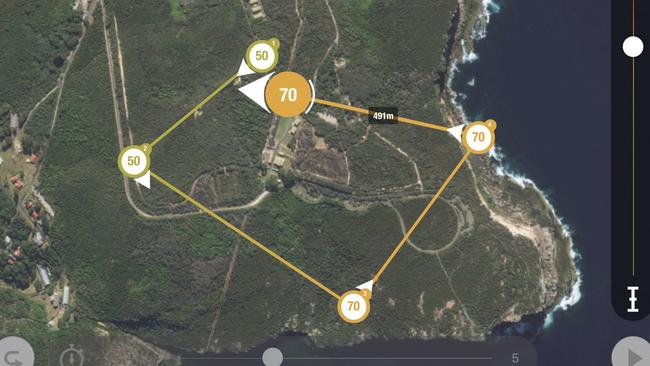
On location I only had to perform pre-flight checks, making sure GPS was connected before taking off. It worked well with wireless connectivity throughout except for one glitch where I had to manually land the drone.
The danger is you can create flight plans that work with GPS but take the drone out of sight — a breach of air safety regulation — or outside the range of the wireless connection with the drone. This can be up to 2km with the Skycontroller. However you must be able to see the drone and control it.
The software does let you regain manual control of the drone, abort a flight plan, and return it to home, but that requires you to be within wireless range.
If you want more functionality you can buy apps such as Autopilot for Bebop and Follow Me Bebop, which will program the drone to track you or circle around you taking video.
The Bebop 2 is quite different in design to its predecessor. It has a sturdier design. At last, the old way of securing the battery with a velcro strap is gone. On Bebop 2 it clips into place securely.
The downside on the Bebop 2 is that you are stuck with 8GB of internal storage without microSD card support. While the massive Skycontroller Black Edition extends your connection range, and supports first person view (FPV) glasses, it’s too big and heavy, especially when compared to DJI’s.
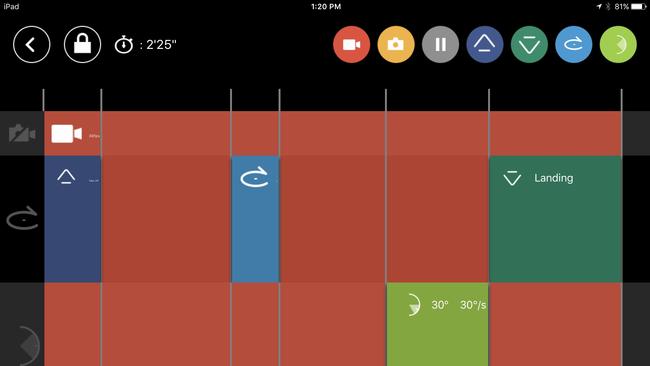
Battery life is better with the drone’s big 2700 milliampere hour battery, up from 1200 mAh with Bebop mark 1. I got more than 20 minutes flying time, double that of Bebop 1. Further, as the Skycontroller has an identical battery to the drone but uses less power, I could swap the batteries around to extend flying time.
Bebop 2 retains a 14-megapixel fisheye lens camera. You can digitally change the angle of images by 180 degrees.
The camera shoots full HD 1080p video and 16:9, 4:3, and fisheye photos. It’s good but not in the class of the 4K camera on the more expensive DJI drones.
Rating: 7/10
Price: $900 Bebop 2 only, $1300 with Skycontroller
DJI Phantom 4
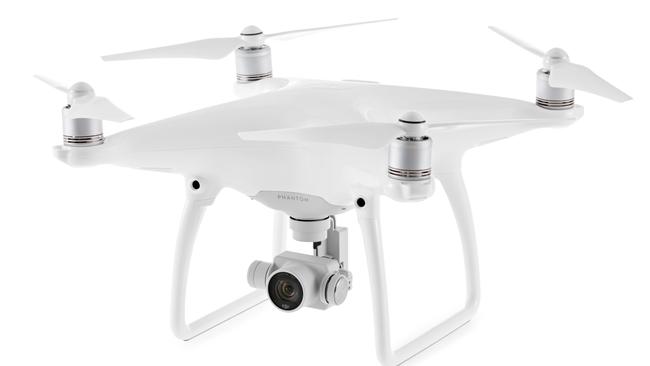
Chinese manufacturer DJI positions itself differently to Parrot. While the French outfit focuses on entry-level drones, DJI makes hardier, more powerful drones with cameras that take 4K video at 30fps and 12-megapixel images.
You control a gimbal to move the camera around. But there’s a premium to pay, with the Phantom 4 considerably more expensive than the Bebop 2.
DJI takes a careful approach to pre-programmed flight navigation. In a nutshell, you manually fly and record any route first before you can fly it automatically. To begin, you launch the drone and let it hover, then select smart settings from the DJI Go app and make your way to the waypoints function. There were also some initial choices to make such as the return-to-home altitude, which you make sufficiently high to clear all obstacles.
As an added safety feature, DJI says you can’t select waypoints if you are within no fly areas close to airports.
After selecting “new mission” it’s a matter of clicking a button at the left-rear of the controller to add a waypoint with the drone at the location, height and orientation that you want reproduced. After setting waypoints, I made some final choices such as whether the drone hovers or returns home after flight.
Press “apply” and the Phantom 4 repeats the mission, giving you time to play with the gimbal settings and take the photos and videos when you want. It’s easy to pause, stop and return to manual operation. Voice prompts tell you what the drone is doing from afar, such as “returning to home”. However, setting waypoints is more tedious than with Bebop 2.
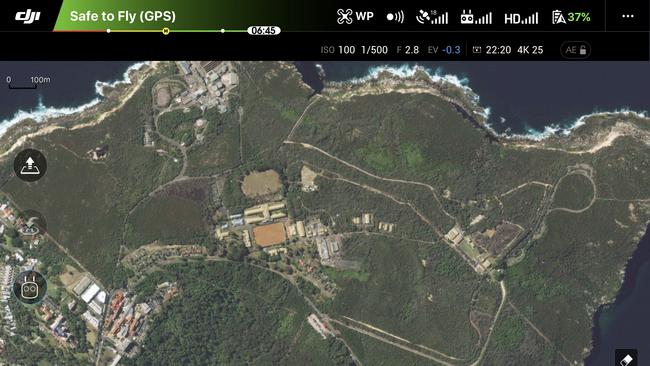
The Follow Me feature, which involves getting the drone’s camera to lock on to the user’s image, is neat and The Phantom 4 is nothing if not persistent. It was like being shadowed by an alien. Wherever I started walking, this drone just kept coming after me. But I could see the potential for, say, videoing yourself jogging or pedalling away on a bicycle.
A variation of Follow Me called Point of Interest allows the drone to orbit around a locked-on object. I also tried the TapFly feature where the drone flies to the point you tap on its camera view.
Apart from their slick, sturdy design, I find DJI drones easy to pilot and stable in the air. Mine had locked onto 18 satellites which no doubt helped.
Meanwhile, an obstacle-sensing system lets the drone fly upwards if the camera detects an obstacle in its path from up to 15m away. There’s also a Sports Mode where the drone can fly up to 72km/h, but without safety support technology you’re on your own.
As with Parrot Bebop, you can use third-party apps for more detailed flight pre-programming such as the Autopilot for DJI Phantom, Inspire and Matrice Drone app. It costs $47.
There’s a 5350mAh battery that gives you about 20 minutes’ flying time, and its camera shoots 4K at 24, 25 and 30 fps, up to 120 fps at 1080p HD and 12-megapixel stills. If you have the money to spare, there is no better drone.
Rating: 8/10
Price $2399


